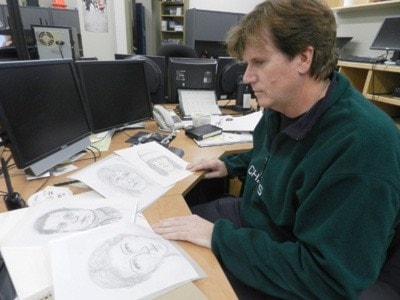As Abbotsford Police Const. Don McKenzie sketched the suspect as described to him by the 13-year-old victim, he thought, “This can’t be right.”
The drawing of the man who had grabbed the girl was emerging into a cartoonish character with bulging eyes, dark curly hair, a high forehead, large ears and a square face.
But the teen declared the depiction was accurate, and the composite sketch was then shown to officers within the Abbotsford Police Department (APD) in hopes of identifying him.
Someone recognized the man from previous dealings, and he was arrested for the crime. He looked uncannily like the drawing that McKenzie had produced without ever having met him, and the victim confirmed him as the assailant, leading to charges being laid.
Such is the impact of the composite sketch artist.
McKenzie, an officer in the APD’s forensic identification section, said the sketches are not appropriate in every case but can be useful for more serious crimes, such as violent attacks and sexual assaults.
He said the key to an accurate sketch is not artistic talent, but the connection that the artist makes with the victim, who is often still traumatized from what occurred.
“The drawing ability is secondary, but it’s the interview and how you talk to people that draws out the information to make the drawing ... It’s getting them to trust you enough and relax enough to let the process flow.”
McKenzie said the procedure can take a few hours, as he collaborates with the victim to ensure the details are correct. They search through the FBI Facial Identities Catalogue, which shows hundreds of faces divided into categories – such as jawline, forehead, eyes and ears – with the rest of the face blocked out.
McKenzie points out that even notorious prohibition-era gangster Al Capone has his mugshot included in the catalogue.
The drawing is adjusted until the victim is satisfied that it is an accurate depiction.
The idea is not to have an identical representation.
“A composite is a memory, and you’re trying to capture that memory on a piece of paper. The drawings don’t look exactly like the person, but something about it might remind you of them,” McKenzie said.
The sketches are shown first to officers, and often don’t go any further than that – as in the recent case of a female purse-snatcher. McKenzie worked closely with the victim to sketch the assailant, who was then recognized by an officer. The woman was arrested and charged with robbery.
 The sketches are only released publicly if police need help to further an investigation, such as in the case of a suspect in a sexual assault in Abbotsford in mid-December. The victim was an 18-year-old girl who was walking through a field when a man grabbed her, groped her and attempted to force her into a sexual act.
The sketches are only released publicly if police need help to further an investigation, such as in the case of a suspect in a sexual assault in Abbotsford in mid-December. The victim was an 18-year-old girl who was walking through a field when a man grabbed her, groped her and attempted to force her into a sexual act.
No suspects have been arrested in that incident.
McKenzie said his job can also result in identifying false crime reports. For example, a teen who misses curfew might make up a story to explain his lateness to his parents.
He might describe an assault that took place, resulting in police being contacted. If there are suspicions about his story, McKenzie can be called in to attempt to complete a suspect drawing.
Sometimes it doesn’t go any further. At other times, the supposed victim will speed through the process, quickly choosing facial characteristics in the catalogue and giving the OK to McKenzie’s sketch with little or no revisions.
McKenzie can usually zone in on these situations, backed by his intuition as a police officer with 27 years’ experience, including 10 years in Vancouver walking the Downtown Eastside. He joined the APD in 1995 and currently works on crime scenes, gathering forensic evidence, CSI-style.
McKenzie has always had a love for art, but didn’t think about using it in his job until he met and spoke with an RCMP composite artist working on a case about 10 years ago.
He then took a one-week course offered by the RCMP, and has taken several other courses since, including training in three-dimensional work such as recreating facial features on a skull.
One of his first composite drawings was of a suspect in a sexual assault. The victim had reported a similar crime five years before, but said the two attacks involved different men.
Police compared McKenzie’s drawing with a composite sketch done after the woman’s previous report, and the two illustrations were almost identical, although done by different artists.
This indicated to police that she was using the same made-up suspect description in both cases.
McKenzie said he gains great satisfaction from using the sketches as a complement to other investigative tools.
“If someone is a victim of a crime and there’s a way you can draw the information out of them to create a graphic image of their memory ... it can help solve cases.”
